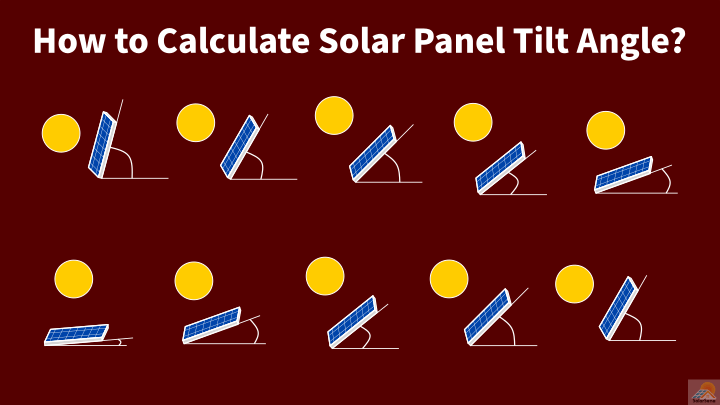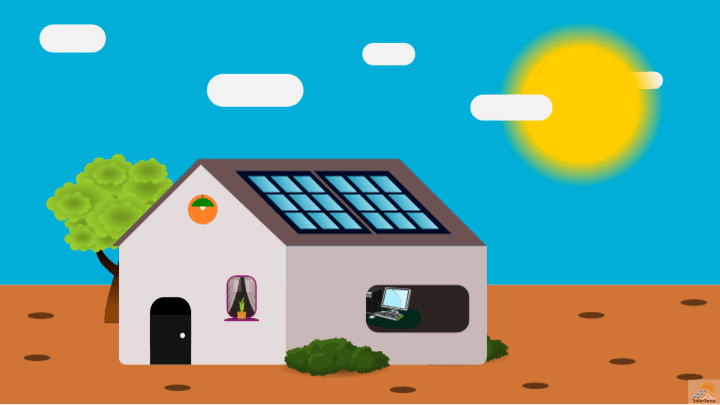Solar panels convert sunlight into electricity. When the rays of the sun strike the surface of photovoltaic panels, the sunlight is absorbed by the photovoltaic material inside solar panels. And the absorbed solar energy is converted into a type of electricity. In the case of solar thermal panels, we get thermal energy instead of electricity.
This absorption of the sunlight by panels is maximized when solar panels are oriented at a particular angle, which we called the optimal angle for solar panels. In the following part of the article, we will learn about the tilt angle and methods to calculate the tilt angle.
If you do not want to go through the trouble of reading this article, you can quickly find the optimal tilt angle using SolarSena’s tilt angle calculator. The calculator gives a better estimate of the optimal angle than the methods discussed below.
What is the tilt angle for solar panels, and why it’s so important?
Before heading directly to the calculation sections, let us understand what we mean by the tilt angle and why there is a need to find the optimal tilt angle.
The solar panel tilt angle is the angle made by panels with the ground surface. It is a positive number and expressed in the degree. When the angle is 0°, it means panels are fully flat, parallel to the ground. And 90° indicates solar panels are perfectly vertical, perpendicular to the ground.

Why optimize your solar panel tilt angle?
As said earlier, solar panels absorb the falling solar energy and convert it into electrical energy. So, if we want to maximize power production, we must maximize the absorption of solar energy. It happens when the rays of the sun strike perpendicular to the surface of solar panels.

Thus, it is clear that panels must be inclined at an angle such that the surface of panels remains perpendicular to the sun’s rays. However, this is not as easy as it seems since the position of the sun keeps changing every hour and month. Although we can locate the sun’s position in the sky with the help of the solar elevation angle, it is not possible for us to always face panels in front of the sun unless you are using solar trackers. Sun navigates from east to west during the day and also changes its position seasonally. For example, on bright, hot summer days, the sun will be overhead, in the middle of the sky, while in the cold wintertime, it will be near the horizon.

If you live in the United States, you would have noticed the sun will be overhead at noon in the summer months (May to Aug). And it would be in the southern sky in winter (Dec to Feb).

These hourly and seasonal changes make it impossible for us to always orient panels facing the sun. That is why we need an optimal tilt angle that can account for both hourly and seasonal changes.
Calculating optimal tilt angle for fixed solar panels
Fixed solar panels are permanently installed at a particular angle. There are no adjustments once mounted. They are the most common and convenient choice for individuals and small businesses.
As a general rule, for fixed solar panels, the optimal tilt angle is equal to the latitude of the location. For example, if you live in Los Angeles (34.05° N), the optimal tilt angle for your solar panels would be 34°.
This tilt angle accounts for both hourly and seasonal changes in the sun’s position. Your panels will produce solar power in the morning and the evening, but most power will produce around noon. Panels will work in all seasons, with summer giving the highest power. The recommended direction for panels in Los Angeles is south. You can use SolarSena’s direction calculator to find the best direction for your solar panels.
The table below gives the optimal tilt angle for solar panels in some well-known places across the world.
| Location | Latitude | Optimal tilt angle |
|---|---|---|
| New York, US | 40.71° N | 41° |
| Los Angeles, US | 34.05° N | 34° |
| Toronto, Canada | 43.65° N | 44° |
| London, UK | 51.50° N | 52° |
| Berlin, Germany | 52.52° N | 53° |
| Madrid, Spain | 40.41° N | 40° |
| Tokyo, Japan | 35.67° N | 36° |
| Seoul, South Korea | 37.56° N | 38° |
| Sydney, Australia | 33.86° S | 34° |
| Wellington, New Zealand | 41.27° S | 41° |
| Hong Kong, China | 22.31° N | 22° |
| Istanbul, Turkey | 41.00° N | 41° |
Latitude increases as we move away from the equator, toward the poles. With that, the optimal tilt angle also increases. This we can see from the below diagram. Thus, countries closer to the equator have a lower tilt angle than countries closer to the poles. On the equator, the optimal angle will be 0°, and at the poles, though no one lives there, it is 90°.

Optimal tilt angle for fixed solar panels in the United States
From the previous map, most of the United States falls between 30° N and 45° N. Thus, the optimal angle for most of the US would be between 30° and 45°. The table below gives some examples.
| Location | Latitude | Optimal tilt angle |
|---|---|---|
| Boston | 42.36° N | 42° |
| New York City | 40.71° N | 41° |
| Raleigh | 35.77° N | 36° |
| Miami | 25.76° N | 26° |
| Salt Lake City | 40.76° N | 41° |
| Austin | 30.36° N | 30° |
| Denver | 39.73° N | 40° |
| Phoenix | 33.44° N | 33° |
| Las Vegas | 36.17° N | 36° |
| Los Angeles | 34.05° N | 34° |
| San Diego | 32.71° N | 33° |
| San Francisco | 37.77° N | 38° |
| Seattle | 47.60° N | 48° |
For an exhaustive list of all major US cities, follow this link.
Calculating optimal tilt angle for seasonally adjusted solar panels
Sometimes, the performance of fixed solar panels is not satisfactory, and you want to further optimize the tilt angle. Or they want to boost the solar power for a selected duration of the year, e.g., summer or winter. In such cases, we desire to estimate the optimal tilt angle for that portion of the year. In this section, we will calculate the optimal tilt according to seasons.
Seasons and months depend on your geographical location. The following table presents seasons and months according to both hemispheres.
| Months | Northern hemisphere | Southern hemisphere |
|---|---|---|
| March to May | Spring | Fall |
| June to August | Summer | Winter |
| September to November | Fall | Spring |
| December to February | Winter | Summer |
The sun is overhead in summer and winter, near the horizon. As a result, the optimal tile angle on bright summer days is smaller, and solar panels are horizontal, parallel to the ground. On the other hand, during winter, the sun is at lower altitudes. Consequently, we have to incline our solar panels vertically, at higher tilt angles.

For the rest two seasons (spring and fall), the angle is in-between.
Tilt angle during spring and fall
During spring and fall (or autumn), the general rule holds. Therefore, the optimal tilt angle during these seasonals is equal to the latitude of the place. For Los Angeles (34.05° N), the optimal tilt angle in spring and fall equals 34°.
Tilt angle during summer
In summers, panels would be nearly flat. There are two methods to calculate the angle. Both of them are as follows:
Method 1
Method 1 is simpler, but the estimate is less accurate.
The optimal tilt angle for solar panels during summer equals the latitude of the location minus 15°. For Los Angeles (34.05° N), the tilt angle in summer equals 34−15 = 19°.
Method 2
Method 2 gives a better estimate.
The optimal tilt angle for solar panels during summer is the latitude of the place times 0.9 and minus 23.5°. In the example of Los Angeles (34.05° N), the tilt angle is 34×0.9−23.5° = 7.1° ≈ 7°.
As we see, there is a difference of 12° between both methods.
Even method 2 is inefficient. From SolarSena’s title angle calculator, the more accurate angle is 13°.
Tilt angle during winter
In winters, panels are steepest.
Method 1
The optimal tilt angle for solar panels during winter is the latitude of the location plus 15°. For Los Angeles (34.05° N), the tilt angle in winter equals 34+15 = 49°.
Method 2
The optimal tile angle for solar panels in winters is the latitude of the place times 0.9 plus 29°. In the case of Los Angeles (34.05° N), the angle is 34×0.9+29° = 59.6° ≈ 60°.
According to SolarSena’s tilt angle calculator, the angle is 55°.
The table below summarizes all the formulae.
| Season | Tilt angle (method 1) | Tilt angle (method 2) |
|---|---|---|
| Spring/fall | =latitude | =latitude |
| Summer | =latitude−15° | =latitude×0.9−23.5° |
| Winter | =latitude+15° | =latitude×0.9+29° |
The solar panel angles for seasonally adjusted panels in different US cities are calculated in the table below.
| Location | Spring/fall | Summer | Winter |
|---|---|---|---|
| Boston | 42° | 15° | 67° |
| New York City | 41° | 13° | 66° |
| Raleigh | 36° | 9° | 61° |
| Miami | 26° | 0° | 52° |
| Salt Lake City | 41° | 13° | 66° |
| Austin | 30° | 4° | 56° |
| Denver | 40° | 12° | 65° |
| Phoenix | 33° | 7° | 59° |
| Las Vegas | 36° | 9° | 62° |
| Los Angeles | 34° | 7° | 60° |
| San Diego | 33° | 6° | 58° |
| San Francisco | 38° | 10° | 63° |
| Seattle | 48° | 19° | 72° |



